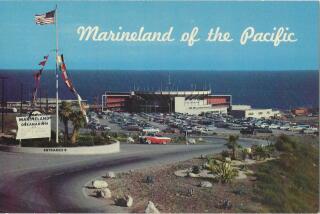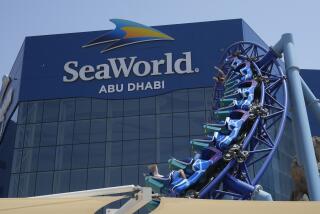Groups Say Sea World Is Blinding Dolphins : Animal Rights: A coalition claims the park’s petting pool is damaging the eyes of the mammals, but a curator called that charge “balderdash.”
- Share via
The man who trained Flipper joined three animal rights groups Tuesday to accuse Sea World of blinding the 18 dolphins and whales that live in its petting pool, but a curator at the private theme park called the charges “balderdash.”
Armed with photographs and a laboratory analysis of chlorine levels, Richard O’Barry, the former trainer of the five dolphins who played Flipper in the 1960s television series, said a quick visit to Sea World had convinced him that the 18 animals are losing their sight in the 80-foot-long pool.
“Every one has their eyes closed. They’re closing their eyes for a reason,” he said, adding that dolphins’ horseshoe-shaped pupils usually are clearly visible. “I can’t prove it without an examination. But they’re going blind--just take my word for it.”
Scott Trimingham, president of the Sea Shepherd Conservation Society, agreed. “These animals’ eyes are deteriorating. There are sunken black holes where their eyes should be,” he said.
Jim Antrim, vice president and senior curator of marine mammals, acknowledged that Sea World has never formally studied the effects of chlorine on marine mammals. But Antrim called O’Barry’s and Trimingham’s assertions “preposterous balderdash.”
“The charge that we would wantonly do something to damage or blind our animals is the most absurd thing I’ve ever heard in my life,” he said.
Of the 16 dolphins and two pilot whales that live in the 13-foot-deep pool, two have “some degree of vision impairment” that was incurred before 1979, when the petting pool opened, Antrim said.
“The animals will squint sometimes, just like you or me, but it’s unrelated to chlorine or anything else environmental,” he said, adding that the addition of chlorine is necessary to offset bacteria from animal waste in the enclosed pools.
“These people have deified these animals,” he said of O’Barry, Trimingham and the representatives of San Diego Animal Advocates and the Fund for Animals who staged an afternoon press conference.
Trimingham supported his group’s demands--for a larger, less crowded tank and lower chlorine levels--with a laboratory report of two samples he said he collected at the park. The sample taken from the petting pool had 0.6 milligrams of chlorine in each liter, about three times that of a sample taken from the marine mammal pool, which tested at 0.17 milligrams per liter, Trimingham’s test showed.
When presented with these figures, Antrim said they were a bit low. He said the park’s pools are tested 10 times a day in order to keep the chlorine level constant--from 0.5 to 1.3 milligrams per liter.
For dolphins and whales, which have a mucous layer in their eyes to protect them from salt water, this amount of chlorine is not an irritant, Antrim said. San Diego tap water has an average of 1.5 milligrams of chlorine per liter, he said.
According to Dr. Homer Malaby, an animal care specialist with the U.S. Department of Agriculture, which regulates the park, the acceptable level of chlorine is anywhere from 0.3 to 3.0 milligrams per liter.
O’Barry scoffed at the USDA’s opinion, saying, “They’re inspecting hot dogs one day and dolphins the next.” But he said his broader concern is that children learn the wrong thing at a petting pool--namely that dolphins are beggar-like animals that exist only for the amusement of humans. In the wild, he said, dolphins will swim 40 miles a day.
“That space is not big enough for one dolphin,” he said of the pool.
But Antrim called the petting pool “a very popular exhibit that we feel is very educational” to the park’s 3.8 million visitors a year.
More to Read
Sign up for Essential California
The most important California stories and recommendations in your inbox every morning.
You may occasionally receive promotional content from the Los Angeles Times.













